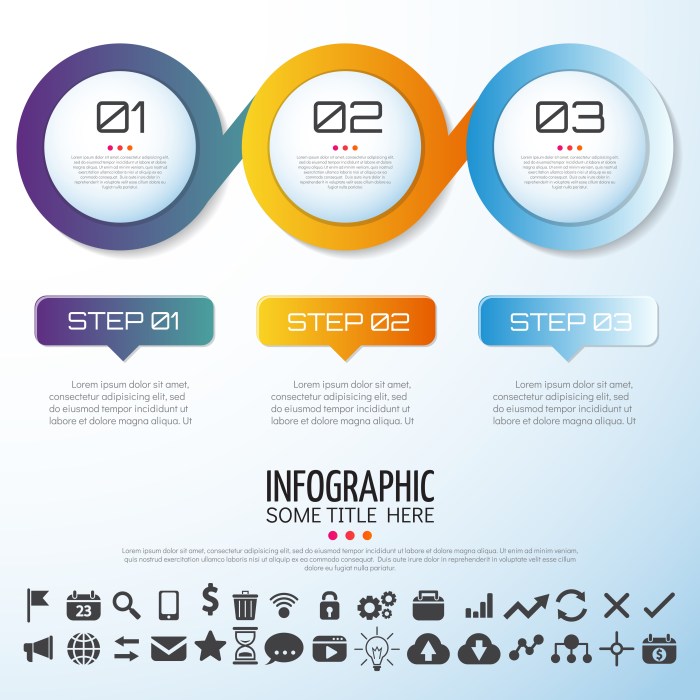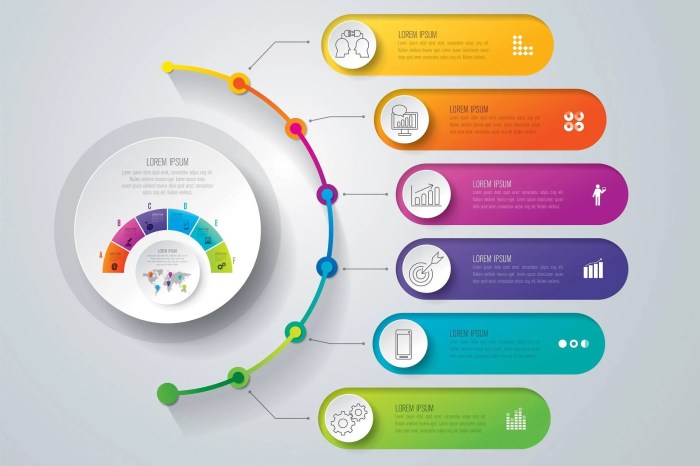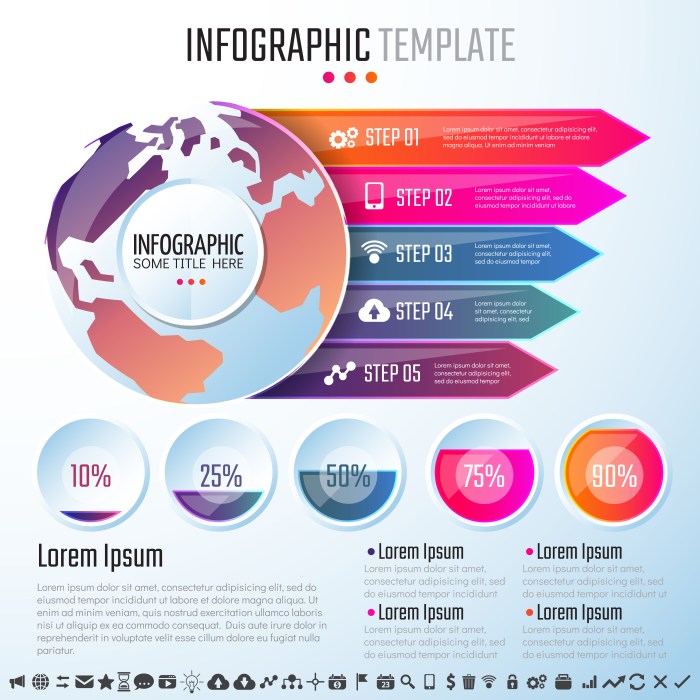Crafting Compelling Infographic Designs: A Guide to Visual Storytelling
Exploring the world of infographic design opens up a realm where visual creativity meets informative storytelling. From the significance of visual elements to the tools and best practices, this guide delves into the art of creating captivating infographics that resonate with audiences.
As we journey through the key elements and strategies, you'll uncover the secrets to crafting visually stunning and engaging infographics that leave a lasting impact.
Importance of Infographic Design

Infographics are powerful tools for conveying information in a visually appealing way. The use of graphics, charts, and images can make complex data easier to understand and digest.
Effective design is crucial in capturing the audience's attention and keeping them engaged. A well-designed infographic can draw viewers in, encourage them to explore further, and ultimately retain the information presented.
Enhancing Audience Engagement
Visual elements in infographics play a key role in enhancing audience engagement. By incorporating eye-catching graphics, color schemes, and layouts, designers can create a visually stimulating experience that captures the viewer's interest.
- Color Psychology: The use of colors can evoke different emotions and convey specific messages. For example, warm colors like red and orange can create a sense of urgency or excitement, while cool colors like blue and green can promote feelings of calmness and trust.
- Typography: Choosing the right fonts and text styles can help guide the viewer's attention and emphasize key points. Bold headings, subheadings, and bullet points can make information easier to scan and comprehend.
- Data Visualization: Infographics excel at presenting data in a visual format, such as charts, graphs, and diagrams. Visual representations of statistics and trends can make information more memorable and impactful.
Successful Infographic Examples
There are numerous examples of successful infographics that highlight the importance of design in effectively communicating information. Infographics from organizations like National Geographic, The New York Times, and TED have set a high standard for engaging and informative visual storytelling.
Elements of Effective Infographic Design
When it comes to creating impactful infographics, several key design elements play a crucial role in capturing the audience's attention and effectively conveying information. Elements such as color scheme, typography, and layout all contribute to the overall success of an infographic design.
Color Scheme
Color scheme is essential in creating visually appealing infographics. Choose a color palette that aligns with the brand or message you are trying to communicate. Use contrasting colors to make important information stand out, while ensuring that the overall design remains cohesive and visually pleasing.
Typography
Typography is another crucial element in infographic design. Select fonts that are easy to read and complement the overall aesthetic of the infographic. Use different font sizes, weights, and styles to create hierarchy and guide the viewer's eye through the content.
Avoid using too many different fonts, as it can make the design appear cluttered and confusing.
Layout
The layout of an infographic should be well-organized and structured to help the audience navigate the information easily. Divide the content into sections and use visual cues such as lines, shapes, and icons to create a flow that leads the viewer from one point to the next.
Ensure that there is enough white space to prevent the design from feeling overwhelming.
Balance of Text and Visuals
To effectively communicate information in an infographic, it's essential to strike a balance between text and visuals. Use visuals such as icons, charts, and illustrations to support the text and make complex information easier to understand. Limit the amount of text to key points and use visuals to enhance and reinforce the message.
Cohesive Visual Hierarchy
Creating a cohesive visual hierarchy in infographics involves arranging elements in a way that guides the viewer's attention from the most important information to the supporting details. Use size, color, and placement to establish hierarchy and ensure that the most critical information is easily accessible and stands out.
Tools and Software for Creating Infographics

Creating visually appealing and informative infographics requires the use of specialized tools and software. Let's explore some popular options and discuss the importance of choosing the right tool based on design needs.
Popular Tools for Designing Infographics
- Canva: A user-friendly platform with a wide range of templates and design elements.
- Adobe Illustrator: Ideal for creating custom graphics and illustrations with advanced editing capabilities.
- Venngage: Offers interactive features and templates for creating engaging infographics.
- Piktochart: Known for its easy drag-and-drop interface and customizable templates.
Comparison of Software Features
| Software | Key Features |
|---|---|
| Canva | Intuitive interface, extensive template library, collaboration tools |
| Adobe Illustrator | Advanced editing tools, vector graphics support, precise customization. |
| Venngage | Interactive charts, drag-and-drop functionality, branding options. |
| Piktochart | Easy-to-use interface, customizable templates, sharing options. |
Choosing the Right Tool for Design Needs
When selecting a software for creating infographics, it is important to consider your specific design requirements. If you need a quick and simple design, tools like Canva or Piktochart may be suitable. On the other hand, if you require intricate illustrations and detailed customization, Adobe Illustrator could be the best choice.
By assessing your design needs upfront, you can ensure that the tool you choose aligns with your vision for the final infographic.
Infographic Design Best Practices
When it comes to creating effective infographics, following best practices is essential to ensure that your design effectively communicates the intended message to your audience. This section will cover key tips and strategies for creating impactful infographics that are visually appealing and easy to understand.
Importance of Simplicity and Clarity in Design
In infographic design, simplicity and clarity are crucial for ensuring that the information presented is easily comprehensible for the audience. Complex and cluttered designs can overwhelm viewers and make it difficult for them to grasp the main message. To achieve simplicity and clarity in design:
- Avoid overcrowding the infographic with excessive text or visuals.
- Use a clean and organized layout that guides the viewer's eye through the information.
- Stick to a consistent color scheme and font style to maintain visual coherence.
- Ensure that the hierarchy of information is clear, with important points emphasized through size, color, or placement.
- Focus on the key message or data points to avoid diluting the impact of the infographic.
Selecting Appropriate Charts, Graphs, and Icons
Choosing the right charts, graphs, and icons is essential for effectively conveying data and information in an infographic. To select appropriate visuals:
- Match the type of data with the most suitable chart or graph for easy interpretation (e.g., bar charts for comparisons, pie charts for proportions).
- Use icons and illustrations that are relevant to the content and enhance understanding without overwhelming the design.
- Ensure that the style of charts, graphs, and icons is consistent with the overall aesthetic of the infographic.
- Avoid using overly complex visuals that may confuse or distract the audience.
- Opt for easily recognizable symbols and graphics to facilitate quick comprehension.
Maintaining Consistency in Design
Consistency in design is key to creating a cohesive and visually appealing infographic that effectively communicates the intended message. To maintain consistency:
- Establish a visual hierarchy for text, fonts, colors, and graphics to guide the viewer's eye through the infographic.
- Use a grid system to align elements and maintain a structured layout throughout the design.
- Ensure that all design elements, such as icons, charts, and text boxes, are aligned and spaced evenly for a polished look.
- Stick to a consistent color palette and font selection to create a harmonious visual experience.
- Review the design for any inconsistencies or discrepancies before finalizing the infographic for publication.
Last Point

In conclusion, mastering infographic design is not just about creating visually appealing graphics but also about effectively communicating information in a way that captivates and informs. With the right tools and techniques, anyone can elevate their storytelling through compelling visual narratives.
FAQ Compilation
How important are visual elements in infographic design?
Visual elements play a crucial role in enhancing information retention and audience engagement in infographics.
What are some key design elements to consider in infographic creation?
Key design elements include color scheme, typography choices, and layout structuring for effective communication.
Which software tools are commonly used for creating infographics?
Popular tools for designing infographics include Canva, Piktochart, and Adobe Illustrator.
How can one maintain consistency in design throughout an infographic?
Consistency can be maintained by using a cohesive color palette, consistent typography, and uniform icon styles.